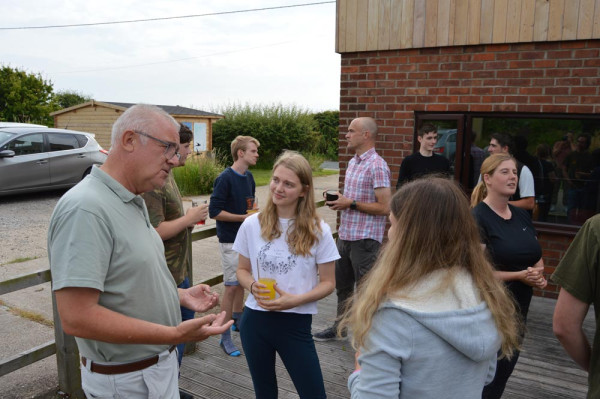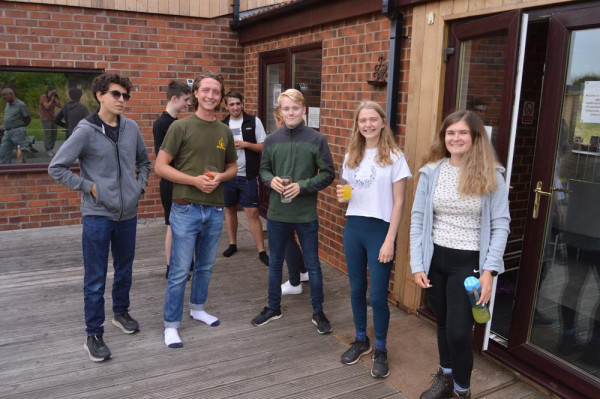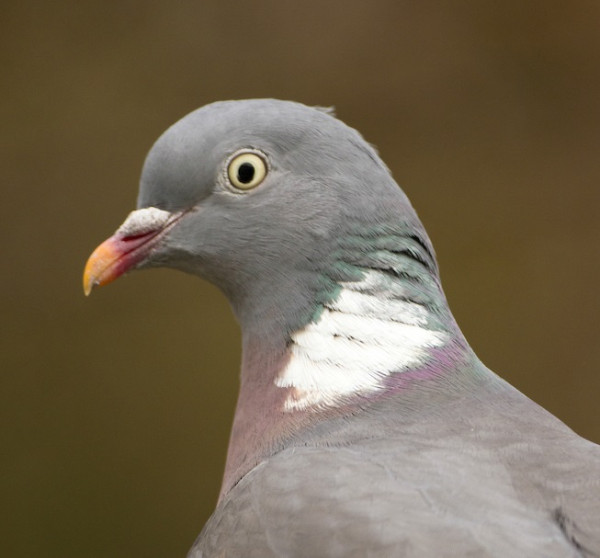
Spurn Young Leaders Course 2021
Attendees of BTO's Young Leaders Course 2021 reflect on what they learned at Spurn.
The BTO Young Leaders course, aimed at16-23 year olds, was held in July 2021 at the spectacular Spurn Bird Observatory in East Yorkshire. Run jointly by BTO and the bird observatory, the course aimed to help attendees develop their leadership skills and better equip them to make a difference.
Monday 26 July 2021 — Alex
After weeks of waiting, the time had finally come. Safe to say I was considerably excited, not just to have the opportunity to visit Spurn Bird Observatory for the first time in two years, but to meet other young birders and wildlife lovers in an amazing setting and experience the opportunities and lessons that would almost certainly be very relevant to my future.
After getting the train to Hull and a bus to Patrington, a few of us were kindly picked up from the bus stop by Nick Moran [BTO Training Manager], who transported us to the observatory, where several people had already arrived.
We immediately got stuck into the icebreaker activity, which involved a bingo grid with interesting facts about each person. To win, we had to go around asking which fact related to which person (including some guesswork because some people hadn’t turned up yet) and fill in the bingo grids when we found a link. This proved to be very entertaining, with some intriguing things learned about each member, including the course leaders.

Once everyone had arrived and chosen a room, we began to settle down in the main room of the observatory to prepare for the afternoon talk, which, excitingly, was being given by previous BTO CEO Andy Clements. As expected, it was enlightening and highly entertaining, with the amount of personal experience and honesty that was involved in this talk teaching valuable, real-world lessons, focusing on his experiences and climb to the role of BTO CEO.
Following this inspirational talk, we had a bit of free time before the light faded. While I came here for the course, it’s impossible to go to Spurn and not go birding! Two groups split off to bird to two different areas. Due to the limited daylight time left, I decided to stick close to the observatory and look for Barn Owls that had apparently been performing well.
It didn’t take long for one to appear and begin putting on a show at a decently close range, giving everyone exceptional views of this awesome species, including one perching briefly. A couple of Whimbrels on the mud on the way back were a nice bonus too.
The other group managed to get down to Kilnsea Wetlands, where they had Short-Eared and Barn Owls and an unseasonable Goldeneye that most people managed to see.
It was then time for the meal, which, for some variety, was in a pub in Easington, the next village north of Kilnsea, instead of at the local Crown and Anchor. This was an opportunity for everyone to get to know each other better, and to enjoy a decent pub meal. Overall, a very enjoyable evening and afternoon: a brilliant introduction to the course, leaving me excited for what the following days would bring.

Tuesday 27 July 2021 (am) — Luisa
On Tuesday morning we were all up bright and early for a great birding session. We headed out in two groups and saw such a great variety of birds at Kilnsea Wetlands, on the estuary and from the seawatching hide. Some highlight species for me included: Spoonbills, Sandwich Terns and a spectacular Great White Egret. Everyone was back and chatting about all things birds over breakfast by eight o’clock.
Next up to start a busy day, Nick Moran shared a great deal of valuable presentation skills from Power Point presentations, speech and presenting data. This included things I had never even considered before such as having colour blind friendly slides or data. We looked at examples of poorly presented Power Point slides and discussed as a group on how we would improve them. I found this a very helpful task knowing I will have to deliver many presentations in the near future.
this was a very rewarding experience because it enabled us to consider the role those with careers in conservation have to play in the real world
Following this we all gave a presentation to the group on a topic we knew about or were interested in. It was great to hear about such a range of topics, ranging from equality in the delivery of COVID vaccinations, to recent birding trips, eusociality in bees and sustainable tourism to list just a few. We all had to state a positive aspect about our own presentations as well as something we could improve; this was a really nice touch as we often immediately think about what we did wrong without giving ourselves credit for what went well.
Afterwards, we had some free time which we could utilise to begin brainstorming ideas for the participant-led tasks we would be leading on Thursday.
Tuesday 27 July 2021 (pm) — Iris
After lunch, we started a session focused on partnership working – led by Shaun Robson who is the warden at RSPB Lytchett Fields in Dorset. We talked about the importance of involving many different groups when creating an area of conservation – this includes the obvious groups that we came up with straight away (councils, landowners etc.), but we also thought about the importance of involving smaller parties such as local schools and dogwalkers, especially in a new project. This discussion made us think deeply about aspects of conservation that we had perhaps not considered before, and helped us to realise the importance of communities when starting anything that has the potential to change an already-established place. It was especially informative owing to the fact that Shaun gave us real-life examples about challenges and obstacles that were faced when creating Lytchett Fields.

After a short break, we had our next activity: 'networking and evangelising'. This was one of the most interesting and unusual activities that I was able to take part in during my amazing time at Spurn. After splitting into pairs, we were given a role, as well as a task that we had to accomplish at a 'photography awards ceremony', all of the roles being in the field of conservation for example, employee of a nature reserve – the task for this person might have been to find funding for a new project). Then we attended the prize giving at the 'Natural History Museum' – also known as the decking outside Spurn’s kitchen. We had to liaise with the numerous photographers, politicians and CEOs who had attended the prize giving too – whilst trying to accomplish the tasks we had been given at the start of the evening. Sometimes I found it hard to believe the BTO staff weren’t professional actors! Apart from being really fun, this was a very rewarding experience because it enabled us to consider the role those with careers in conservation have to play in the real world – it was an experience I won’t forget quickly.
In the evening, our meal was accompanied by amazing views over the Humber estuary as the tide rolled in and out – we then went on to Kilnsea Wetlands to fit in some birding before returning to Spurn as darkness descended. We also managed to see some really cool moths before bed as well!
Wednesday 28 July 2021 (am) — Ollie
On our penultimate morning of the course, everyone was up again at 5:30 for a mix of sea watching, wetland birding and sifting through a rather soggy moth trap. Despite the overnight rain, we still had a good variety of species waiting for us. Once everyone had returned to the observatory from their various wildlife ventures, the day started with talks from Faye Vogely [BTO Youth Engagement Manager] about her journey into the conservation world, giving interesting insight into the joys and challenges of the sector. The importance of realising your own boundaries and maintaining a healthy work-life balance to avoid burnout was stated, as well as looking after your own mental health. This advice was great to hear and gave clarity on any mental health stigma in a workplace.

After this, we then played a “Disaster and Fortune” card game, where we all wrote down a dream job and the stages required to obtain such a job, such as qualifications and experience. Then we were each dealt Disaster or Fortune cards, which either aided or hindered career progression, and we had to figure out how to make the most of the opportunities or tackle the obstacles we were provided. Unfortunately, I received three disaster cards which made things a little difficult! Although it did make me realise that there’s often multiple routes to the same job. Just before lunch we had a group discussion chaired by RSPB reserve warden Lizzie Bruce about ‘walking the walk’ in conservation. Here we discussed leading by example and acknowledged how important it can be, when in positions of power that come under regular public scrutiny, to help consolidate support. We also talked about how best to use social media as a platform to channel your passion for conservation whilst informing people of current issues and the work going on around them. A small debate on twitching vs birding also came up which provided some good entertainment!
Over lunch, we received feedback from Lizzie and Faye on mock cover letters that we prepped before the course for various roles with the BTO and RSPB. This advice was really valuable as we received useful tips on how to best convey our enthusiasm and skills for the job, whilst standing out from the crowd.

Wednesday 28 July 2021 (pm) — Keir
After lunch it was time for the training session on guided walks. I had heard from previous attendees of the course that this was likely to be one of the sessions that tested us on “how a leader responds to an event going wrong”. A friend of mine also helpfully described it as: “don’t worry when Nick faints; he’s just pretending”. Needless to say I was prepared.
First up was Alex. His session was going to be a bird walk around the Observatory with an emphasis on bird song. The questions came quick and fast, ranging from how to ID Woodpigeon calls and descending into who could ask the silliest question. The most amusing incident has to be when Nick Whitehouse insisted on taking a phone call and then talked at the top of his voice. He was so convincing that we couldn’t actually tell whether it was an emergency, or he was just joking around.
Next up was Brook, who had possibly been the most zealous in his questions to Alex, who took us up to the Spurn Observatory viewpoint. However, as we walked along, I noticed Lizzie and Shaun slipping further and further behind…
Brook hadn’t seen.
Noticing that the viewpoint could only carry 12 people Brook let everyone else get on while he directed us from below. The focus of the session was on birds in flight and we scoured the sky in search of birds such as Kestrels. Meanwhile Brook commented on the fact that it was “handy that there were only 12 of us,” still failing to clock the absent two. It took a lot of restraint from the rest of us not to shout it out when we noticed.
The following walks continued in a similar vein. Lizzie became the one to keep your eye on as if you turned your gaze away even for a second, she would be off hiding somewhere.
In Conor’s butterfly walk we weren’t sure whether Shaun was making up butterflies, although they actually turned out to be real. When it was George’s turn, he failed to keep eyes on Lizzie, and she was off again!
In Emma’s walk she had to deal with a fainting Faye done with brilliant acting. This was probably the best managed incident in the entire set of activities as Emma quickly asserted control over the situation. Unfortunately, the sabotages continued apace. When it was Iris’ turn, we went down to the sea, but unfortunately the tide was out and so the walk focus on aquatic mammals had to be swiftly adapted, but proved to be very fun pointing out imaginary mammals that we pretended to see.

Next it was my go. After experiencing the amount of chaos inflicted by the ferocious five (Faye, Shaun, Nick W, Nick M and Lizzie especially) I decided I would go for an entirely different tack. In hindsight it was definitely too much like a drill sergeant! My event was initially designed to use the viewpoint. Using the scope I had been lugging about I carried out a quick health and safety assessment (in order to pass the time as well as a good thing to do before any activity) before looking at birds. Seeing the new location with new capacities for people to escape I decided to double down on the first bit.
The 10-minute run through of first aid before going to the “main event” became the focus of my walk. The rain quickly thwarted my plans though as we ducked under the cover of a tree. With an attempt to go on a phone call during the health and safety assessment I tried to confiscate Lizzie’s phone. It was a painful 10 minutes explaining waders, putting in a back marker and going through health and safety. Yet, it was largely crisis-free (Despite Nick falling to the floor with laughter at some of my explanations for things).
Luisa took us on another good bird walk back in the direction of the Observatory to shelter from the torrential rain, which featured another of Lizzie’s usual running off. In the final two there were too particularly memorable moments Luke’s decision to get a fake bleeding Faye to go and get her own First Aid Kit and Lizzie’s not one but two escapes during Ollie’s talk on moths.
we all packed up and began our journeys home equipped with many new leadership skills, great memories and new friends
After analysis of what went well and what could be improved it was Emma’s turn to run the first young leaders designed event. All participants had been told at the start of the course that on the final day they’d be asked to run a 20-minute activity of their choosing, to highlight skills they’d learned. Emma’s activity a cross between normal and bird charades and was a massive success. Faye and Lizzie’s competitive sides quickly came across as we fought to get as many correct charades as possible in short 30 second bursts. By the end, between laughing about Shaun’s impression of the Queen, our team was ultimately defeated.
We went and had dinner overlooking the Humber estuary from the pub and watched Dunlin and Knot fly past in thick flocks. Afterwards, a few of us headed into Kilnsea Wetlands to watch the sun go down whilst looking at Ruff, Spoonbills and Caspian Gulls. Going back on that last evening I felt a tremendous sense of bittersweet sadness at something coming to an end that I had loved being part of.
Thursday 29 July 2021 — Luisa
Our last morning at Spurn was well spent with us all heading out around 5:30 to go birding. Then we had a busy morning ahead of us with the rest of our participant-led tasks.We had planned these over the past few days, so we were all excited to see what everyone had come up with.
We had a wide variety of tasks, all of which were very successful. From completing citizen science, birding in teams, Pictionary and who am I? games, to ethical and scientific debates and discussions on mental health and our experiences as young birders. Once we had all completed our participant tasks, we gave each other feedback and had a general summary of the week.
Unfortunately, our time together at Spurn Bird Observatory had come to an end and we all packed up and began our journeys home equipped with many new leadership skills, great memories and new friends.
We would all like to say a massive thank you to Faye Vogely, Nick Moran, Nick Whitehouse, Lizzie Bruce, Shaun Robson and Andy Clements for sharing their experiences and amazing knowledge of careers in conservation. We would also like to thank the BTO, Spurn Bird Observatory and Cameron Bespolka Trust for making this unforgettable experience possible.
The BTO/SBO Young Leaders Course is made possible thanks to generous funding by the Cameron Bespolka Trust. The Cameron Bespolka Trust is a charity that has been set up in Cameron's memory to inspire young people to love and appreciate animals, in particular birds, nature, and our environment. By experiencing the outdoors first hand, teenagers can connect with nature and make a difference to our planet.

Young people are the future of BTO
With your help, we can do more to reach out to, connect with and support them.
Donate to the BTO Youth Appeal today







Share this page